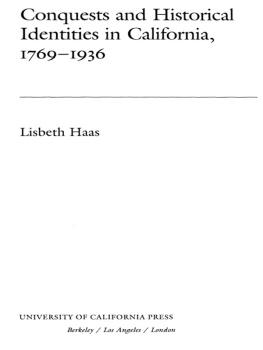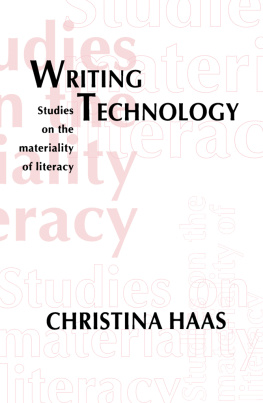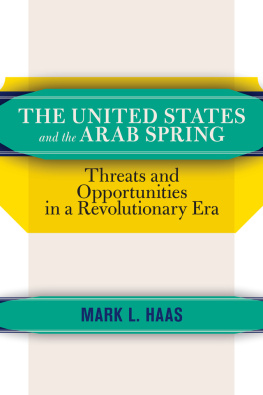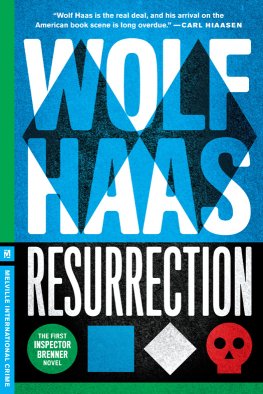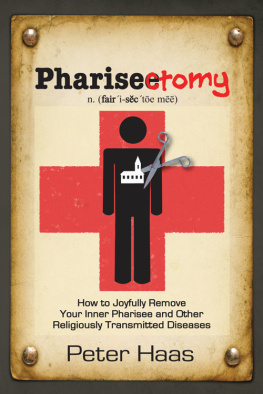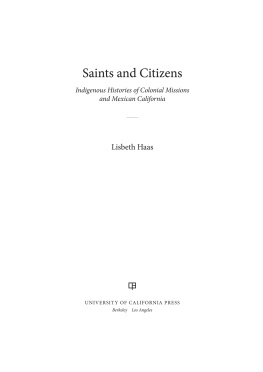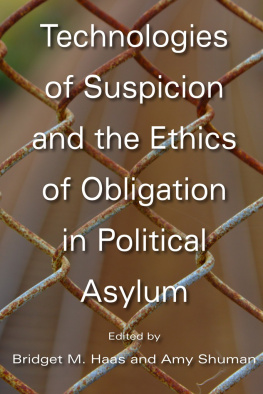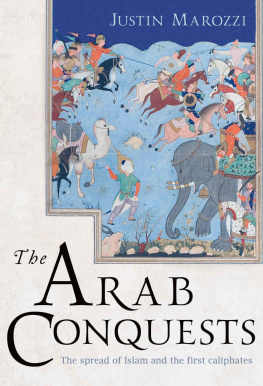Haas - Conquests and Historical Identities in California, 1769-1936
Here you can read online Haas - Conquests and Historical Identities in California, 1769-1936 full text of the book (entire story) in english for free. Download pdf and epub, get meaning, cover and reviews about this ebook. City: Berkeley;Orange;Calif;USA, year: 2011, publisher: University of California Press, genre: Politics. Description of the work, (preface) as well as reviews are available. Best literature library LitArk.com created for fans of good reading and offers a wide selection of genres:
Romance novel
Science fiction
Adventure
Detective
Science
History
Home and family
Prose
Art
Politics
Computer
Non-fiction
Religion
Business
Children
Humor
Choose a favorite category and find really read worthwhile books. Enjoy immersion in the world of imagination, feel the emotions of the characters or learn something new for yourself, make an fascinating discovery.
Conquests and Historical Identities in California, 1769-1936: summary, description and annotation
We offer to read an annotation, description, summary or preface (depends on what the author of the book "Conquests and Historical Identities in California, 1769-1936" wrote himself). If you haven't found the necessary information about the book — write in the comments, we will try to find it.
Haas: author's other books
Who wrote Conquests and Historical Identities in California, 1769-1936? Find out the surname, the name of the author of the book and a list of all author's works by series.
Conquests and Historical Identities in California, 1769-1936 — read online for free the complete book (whole text) full work
Below is the text of the book, divided by pages. System saving the place of the last page read, allows you to conveniently read the book "Conquests and Historical Identities in California, 1769-1936" online for free, without having to search again every time where you left off. Put a bookmark, and you can go to the page where you finished reading at any time.
Font size:
Interval:
Bookmark:
Acknowledgments
I am grateful, first of all, to those individuals who have shared stories about their lives with me. They include my very first informants, people who had been deeply engaged in urban struggles during the 1970s and early 1980s in Santa Ana, California, and whose consciousness of rights came out of their understanding and interpretations of the past; they focused my attention backward in time. I met women who, like Jovita Hernandez, awakened my appreciation for the central role of women in history and subsequently helped to shape my manner of inquiry and interpretation. I thank members of the Juaneo Council of San Juan Capistrano, especially Donald Doram, Evelyn Villegas, and David Belardes, who contributed material that enabled me to finish this book. I am also compelled to express my deep appreciation to those I met, indirectly, in archival documents. Their behavior and ideas defined crucial dimensions of the society in which they lived their lives. Their records informed my understanding of change and endeared them to me.
I am extremely appreciative of the rich body of historiography that historians in my field have produced over the past twenty-some years. My debt to them, and to my colleagues at the University of California, Santa Cruz, is great, and primarily expressed through citations and references to their work in the following pages. I want especially to thank my professors Albert Camarillo, Jeanne Chase, Mary Ryan, Jon Wiener, and Toms Ybarra-Frausto, whose mentorship and ideas shaped my early work on this subject. I was fortunate to have developed fundamental parts of my intellectual life with Victor Zamudio, and will always be grateful to him for those years we shared. From our reading groups at UCSC I want particularly to recognize the astute and helpful commentary of David Anthony, Nancy Grey Osterud, Cynthia Polecritti, Lynn Westerkamp, and especially Dana Frank, who has been a close friend and critic. Their comments on versions of this manuscript enabled me to define this project more clearly. I thank Michael Schuster for his reading of ; our discussions of popular theater, and the very special relationship between our families, sustained me as I wrote the first chapters of this book. Ramn Gutirrez and Sarah Deutsch read the entire manuscript; they provided excellent, detailed criticism that guided my revisions and challenged me to examine and refine my formulation of key concepts. Their own work influenced me substantially, and their comments definitively shaped the final version of this text. My colleagues who were fellows at the Minority Discourse Seminar at the University of California Humanities Research Institute provided an exceptional context to carry my thoughts into new projects after this book was finished. I especially thank Norma Alarcn and George Snchez for the relentless intellectual engagement they brought to reading this and other work; they have inspired me to make yet further interventions into the copyedited text.
My research assistants contributed tremendous energy and intelligence at each stage of the writing of this book. Jos Orosco provided useful commentary and careful notes as we carried out research in the court archives during the summer of 1988. Over the next two years Cerina Herrera created a huge census data base and helped to analyze the output. Her care and insight were invaluable as I worked on the outline of this book, and as I wrote . Toni Nelson-Herrera worked intensively on many aspects of the book as I wrote. Her keen insight and tireless effort and our endless conversations about the larger implications of each piece of the research made my writing more meaningful. Jesus Cisneros provided valuable assistance as I completed the final revisions of the manuscript.
I am very grateful to the University of California, Santa Cruz, for the Faculty Senate Research Grants that supported research assistance and travel as well as manuscript preparation. The Minority Internship Program at UCSC contributed money for research assistance through a valuable mentorship program. I thank the University of California MEXUS program and the UCSC Humanities Division for funding research in Mexico and California. A grant from the National Endowment for the Humanities enabled me to examine theater archives at the Benson Latin American Library, Mexican American Collection, University of Texas, Austin. I am also grateful to UCSC for providing course relief so that I could finish this book. My teaching informed my writing, and I thank my students for their many questions and ideas, which in turn helped me to refine my own.
Zoe Sodja and Cheryl VanDerVeer at UCSC prepared the manuscript with patience and care. They always made it possible for me to finish promptly. Barbara Reitt was the first to edit the manuscript, and her excellent suggestions helped me to revise it. I have enjoyed the skillful editing of copy editor Anne Geissman Canright, who understood the book well. For their effective comments and support I heartily thank Anne, project editor Dore Brown, and general editor Lynne Withey of the University of California Press. Finally, I am very grateful to Chip Lord for his loving presence and careful reading as I completed the book, and to Sophia, for her thirteen years of intelligence, sensitivity, and imagination.
APPENDIX 1
A Note on Quantitative Method: The Federal Manuscript Census, 18601910
The quantitative dimension of this study was developed from the federal manuscript censuses for 1860 through 1910 (excluding the 1890 census, which was destroyed in a fire). These censuses are long forms filled in by the census enumerator who went from door to door to get his answers. The enumerator always recorded the name, birthplace, age, gender, and occupation of each person living in a dwelling. These dwellings were recorded by census number and organized by household, with the head of the household listed first and the information about other household members listed underneath, generally in order of descending age and relationship to the household head. I also organized the material in my data base by households. I found it instructive to note the order in which the enumerator recorded his information, because it often suggested broader structures of rural and town society.
The data bases included information on all 293 households in San Juan and Santa Ana townships in 1860, and 538 households in 1870. By 1880, the number of households in the two townships had increased to 1,214. For that year, I input data on all 176 of the households headed by a person with a Spanish surname, as well as the entire population of San Juan Village (which appeared separate from San Juan Township only in the 1880 census), and randomly selected 30 percent (or 324) of the non-Spanish-surnamed households. The same random selection process was used for the 1900 and 1910 censuses as well; in 1900 1 included the whole area of Orange County, which was formed in 1889. In 1900, 4,688 households were enumerated in the manuscript census. For the data base I randomly selected between 8 and 10 percent of the non-Spanish-surnamed households, and all the Spanish-surnamed households (a total of 241). In 1910, the population had grown to include 8,554 households. I selected from 5 to 20 percent of the non-Spanish-surnamed households, and all the Spanish-surnamed households (574). These percentages were chosen to achieve a statistically significant number of households for each urban and rural area (see below).
Through the data base category Ethnicity I placed individuals together according to their particular backgrounds and larger historical experiences. I've used the terms Californio, Mexican, Indian, European, Anglo-American, and Other Ethnic. The detailed exploration of the emergence of the regional term Californio, and the term's changing social and cultural meaning, accounts for a significant portion of this study, as does analysis of the meaning of Indian, Mexican, and, to a much lesser extent, white identity. The book does not explore the histories of other groups in any depth.
Next pageFont size:
Interval:
Bookmark:
Similar books «Conquests and Historical Identities in California, 1769-1936»
Look at similar books to Conquests and Historical Identities in California, 1769-1936. We have selected literature similar in name and meaning in the hope of providing readers with more options to find new, interesting, not yet read works.
Discussion, reviews of the book Conquests and Historical Identities in California, 1769-1936 and just readers' own opinions. Leave your comments, write what you think about the work, its meaning or the main characters. Specify what exactly you liked and what you didn't like, and why you think so.

